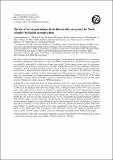Por favor, use este identificador para citar o enlazar a este item:
http://hdl.handle.net/10261/132096COMPARTIR / EXPORTAR:
 SHARE
BASE SHARE
BASE
|
|
| Visualizar otros formatos: MARC | Dublin Core | RDF | ORE | MODS | METS | DIDL | DATACITE | |

| Título: | The use of the oxygen isotopes from diatom silica as a proxy for North Atlantic Oscillation reconstruction |
Autor: | Hernández, Armand CSIC ORCID ; Rubio de Ingles, Maria Jesus; Sánchez-López, Guiomar CSIC; Giralt, Santiago CSIC ORCID | Fecha de publicación: | 12-abr-2015 | Editor: | European Geosciences Union | Citación: | European Geosciences Union General Assembly 2015 Vienna, Austria 12 – 17 April 2015 EGU2015-13201-1 | Resumen: | The North Atlantic Oscillation (NAO) is the main atmospheric circulation mode controlling climate variability in the Northern Hemisphere. Instrumental records of the NAO are relatively short, and therefore proxy approaches are essential to understand its evolution over longer time periods. Diatom oxygen isotope ratios are increasingly being used for palaeoclimatic reconstructions in lacustrine sedimentary records. However, application of this proxy to annual-to-decadal resolution lacustrine records is still in its infancy. To our knowledge, oxygen isotope ratios from diatoms at annual-to-decadal resolution has not been attempted, mainly due to the difficulty in obtaining large enough samples suitable for analysis at this temporal scale. Here we present a high-resolution, ca. 200-year-long, proxy record based on 56 oxygen isotope measurements from Lake Santiago (37 ̊ 50’ N – 25 ̊ 47’W, Azores Archipelago, Portugal). This record will be compared to instrumental data of precipitation and NAO index values to test its robustness to conduct an ancient NAO reconstruction. In detail the oxygen isotope data shows an isotope depletion trend (-3 h), with several interannual oscillations, from 1830 cal yr AD until present. The entire record can be divided into two intervals. The interval, from 1830 to 1938 cal yr AD, displays values above the average (+33h), whereas the interval from 1939 to 2012 cal yr AD shows values below the mean. Since Lake Santiago is a hydrologically closed lake, the oxygen isotope variations are mostly related to the precipitation-evaporation ratio. These results exhibit a good agreement with the rainfall instrumental data with an increase of net rainfall amount through the last decades in the Azores archipelago. Besides this, the short-term recorded isotope excursions (3.5h) are related to the rainfall interannual variability.These patterns suggest that the isotope data from diatom silica in Lake Santiago sediments are directly linked to past precipitation changes on the Azores. Moreover, the precipitation regime in Azores Archipelago (i.e. intra and inter-annual variability) is clearly influenced by the NAO index, thus periods with dominant positive NAO index values (NAO+) are usually characterized by low winter precipitation in the Azores. Conversely, negative NAO phases (NAO-) induce high winter precipitation in the archipelago. Therefore, the oxygen isotope data may be used as a proxy for NAO changes, and thus a proxy for more large-scale changes in the North Atlantic region. | Descripción: | Hernandez, A. et. al. | URI: | http://hdl.handle.net/10261/132096 |
| Aparece en las colecciones: | (Geo3Bcn) Comunicaciones congresos |
Ficheros en este ítem:
| Fichero | Descripción | Tamaño | Formato | |
|---|---|---|---|---|
| Giralt_EGU2015-13201-1.pdf | 44,8 kB | Adobe PDF |  Visualizar/Abrir |
CORE Recommender
Page view(s)
167
checked on 22-abr-2024
Download(s)
63
checked on 22-abr-2024
Google ScholarTM
Check
Este item está licenciado bajo una Licencia Creative Commons

